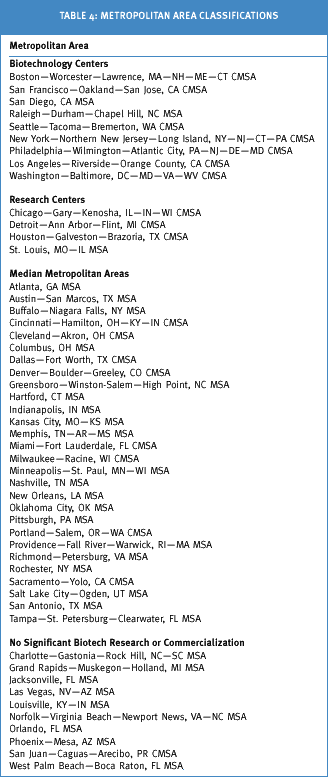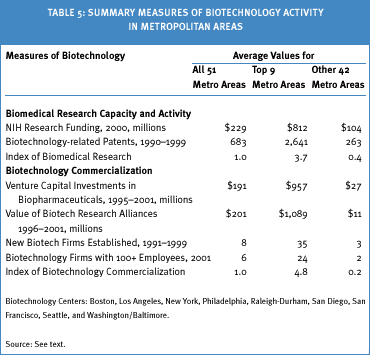|
Week of June 10, 2002 Snapshot from the Field |
|
LOOKING FOR A PREVIOUS STORY? CHECK THE ARCHIVE.
Biotech Not Everywhere, Despite Claims to the Contrary By ADAM BRUNS, Site Selection Managing Editor
If you trust the flood of press and promotional talk, then biotech remedies and solutions are probably being cooked up right around the corner from where you're sitting right now. But, alas, such talk may not be accurate - now or in the near future - says a new report from the Brookings Institution's Center on Urban and Metropolitan Policy.

The report, "Signs of Life: The Growth of Biotechnology Centers in the U.S.," paints a biotech portrait of the country's 51 largest metros, with only a handful having come into clear focus thus far. Even though a 2001 survey revealed that 83 percent of some 113 local and state level ED agencies had targeted biotech as one of their top two targets for industrial development, only the following nine metropolitan statistical areas qualify as Biotechnology Centers:
Of course, definitions of jurisdictions and of terminology mean a lot. Even the report itself states it outright: "There exists no single universally agreed-upon definition of biotechnology ...," but it tries anyway. "Biotechnology is the application of biological knowledge and techniques pertaining to molecular, cellular and genetic processes to develop products and services."
"We used the same definition as folks in the industry use," says author and economist Joseph Cortright, of Portland, Ore.-based Impresa Consulting. "There are other businesses that are peripherally related, particularly medical devices, that we didn't include." Nor were pharmaceutical giants. To put things in perspective, the tenth-largest U.S. pharmaceutical firm (Pharmacia & Upjohn) had 1999 sales larger than the combined sales of the ten largest biotech firms ($7.25 billion vs. $6.99 billion). Recombinant Capital reports more than 10,000 industry alliances during the 1990s. Between 1980 and 2001, pharmaceutical companies entered into R&D agreements worth $17.3 billion with biotech companies, with the value of such agreements escalating rapidly over the past decade. But for the purposes of this report, around 1,000 companies qualified. Thus, cities like Pittsburgh, Nashville Atlanta, Orlando and Louisville are relegated to climber status, with a significant mountain of money to scale. The typical biotechnology center has about eight times as much research activity as other metropolitan areas, about ten times as many large and newly established biotech firms, and about 30 times more venture capital funding. While the prospects appear dim for luring more capital away from those nine centers, hope still floats, as evidenced by those areas where growth is fast and furious. "Five of the nine top biotechnology metropolitan areas - the leaders (Boston and San Francisco) and three other areas in which biotech is growing rapidly (San Diego, Seattle, and Raleigh-Durham) - account for the bulk of the growth of new biotechnology firms," states the report. "Together these five areas have accounted for 75 percent of the new venture capital in biopharmaceuticals in the past 6 years, for 74 percent of the value of research contracts from pharmaceutical firms, and for 56 percent of the new biotech businesses formed during the 1990s." Of the top four pharmaceutical metros, New York and Philadelphia lean more toward research, while Boston and San Francisco are stronger in commercialization. The latter two cities have about ten times as much biotech commercialization as the U.S. mean. Knocking on their door is San Diego, which in the past decade has attracted $1.5 billion in venture capital and $1.6 billion in alliance funding and has created 38 new firms. San Diego now has 31 biotech firms with 100 or more employees. "Over the last decade, the challengers have moved up a lot," says Cortright, primarily by virtue of their entrepreneurial cultures, even if the predominance of biotech venture capital is still squirreled away in the East Coast power centers of New York and Philadelphia. "I think, in terms of institutions that support entrepreneurial activity, the real model here is San Diego, including the University of California-San Diego," says Cortright, citing its strong networking, as well as established intellectual capital like the Salk Institute. "It has a very connected entrepreneurial culture: finance, science and business," he says, and the biotech industry there literally surrounds the university. Some anomalies: While Minneapolis was graded as "median," it outpaced "research centers" St. Louis, Houston and Detroit in its number of biotech companies (9) with more than 100 employees. Also, by limiting the field to the country's 51 largest metros, Cortright says Madison, Wisc., was left out in the cold. The findings amount to one simple, oft-repeated journalistic adage: follow the money. A 2001 survey conducted by PriceWaterhouseCoopers found that between 1995 and 2001, there were 1,109 venture capital investments in biopharmaceutical firms, for an aggregate total of $10.1 billion. About $9.7 billion of that went to the country's 51 largest metro areas, and a whopping $4.9 billion went to just Boston and San Francisco. "I think our critical finding is that even though the research is getting more dispersed, at the same time the commercialization is getting more focused in these nine areas," says Cortright. "We take that as very powerful evidence of clustering. There is a big advantage to being in those areas with workers - you have the positive feedback dynamic, a great place for people who want to start companies, and if you're a biotech manager or technician, it's a great place to learn those skills and to work. Venture capital feeds on that. Among the roughly 700 or so venture capital firms, there are 50 who invest most in biotech, and all but three are located in the top nine metros. 
"As communities think about developing biotech, they need to focus on commercialization and not research," he concludes. "Do you have venture capital firms, and a talented local workforce, who understand both the technical side and the business side? People with those sets of skills are the critical part." He cautions advocates that biotech is not only a time-consuming and risky sector to pursue, but its research can be fugitive, as in the case of an anti-cancer drug developed last year in Portland, Ore., which has since been purchased by Swiss pharma giant Novartis. For those few expensive success stories however, there are dozens of vanishing prospects. "A lot of these good ideas don't pan out," he says. "There is no certainty that anybody with a good idea will eventually have a biotech product." As for raining on the biotech parade, Cortright says it's time for communities to have a realistic picture of where the industry is concentrated and why it's concentrated there, so they'll have an understanding of where it's going. "It's going to be really difficult for many of them to break into that top nine," he says. "I think it's possible, but it's going to take a long time, decades, and it's going to be really expensive, costing hundreds of millions of dollars in research, and similar amounts in private investment. And it's going to be really risky."
©2002 Conway Data, Inc. All rights reserved. Data is from many sources and is not warranted to be accurate or current.
|
